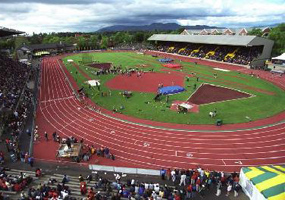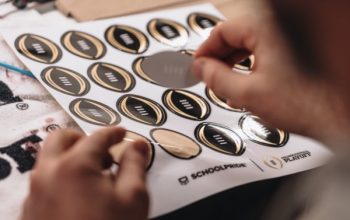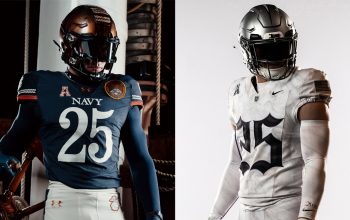The University of Oregon has gone by the name Ducks since around World War II—though not officially until 1978. It’s a name that traces back to the late 1800s—though not officially adopted by the university until 1926—when the team was called the Webfoots—or Webfeet, or Webfooters—which derives from a nickname for people from coastal Massachusetts, or possibly from a derogatory term that Californian miners called western Oregonian miners. And Oregon’s mascot is (kind of exactly) Walt Disney’s Donald Duck because of a handshake agreement from 1947 that was not put in writing until 1973.
Obviously, there are some questions surrounding the Oregon Ducks.
“It’s just a very complicated history,” said University Historian and Archivist Jennifer O’Neal, “both about the term webfoot in itself, but then how it came to be used by our school, and later how we evolved to be known as the Ducks.”
The origin of the University of Oregon Ducks nickname is best summed up by an internal university archive document from 1992 called “The Webfooted Ducks” by Douglas Card, a faculty member at the time. It states, “The question has two parts: why early Oregonians were called Webfeet, and why the university chose it as our nickname or mascot. The very first use of the term is shrouded in misty antiquity.”
While you see references to the term webfoot originating in the northeast and migrating to Oregon, the more likely explanation, based on the research by Douglas Card, is that the term’s roots are local.
“Early Oregonians were called webfoots by Californians because western Oregon was so rainy and muddy,” O’Neal said. “So this term spread to refer to both all Oregonians as well as western Oregon in itself. A myth that was created concerning the idea that we really did grow ‘webbed feet.'”
 In her research regarding the school’s nickname and mascot, O’Neal said she has been surprised at “how involved the sportswriters and journalists were with the process, and also how involved faculty and students were, and how important it was at that time to have such a strong name.”
In her research regarding the school’s nickname and mascot, O’Neal said she has been surprised at “how involved the sportswriters and journalists were with the process, and also how involved faculty and students were, and how important it was at that time to have such a strong name.”
According to O’Neal, “journalist L.H. Gregory, sports editor of The Oregonian, has been credited with coining Webfoots as the school’s athletic nickname.” Though she also points out that, according to Douglas Card’s research, students had been using the term to describe themselves since about 1900. (The image here is from an article by David Weiss on the school’s website.)
The term Webfoot, which was also the name of the school’s yearbook, fell in and out of favor over the course of the early 1900s. Sometimes, journalists would just call the team by its primary color, lemon yellow.
“That was actually one of the reasons why they stopped using it for a time,” O’Neal said, “because they felt maybe it was too wimpy a name or it wasn’t as strong as the Bulls or, say, the Cougars or something like that.”

Even after Webfoots was officially adopted by the school in 1926, according to Douglas Card in “The Webfooted Ducks,” “Sportswriters gradually shortened the moniker to Ducks.” In fact, for two decades from the early 1920s to the early 1940s, the school had a live duck mascot named Puddles.

The informal use of Ducks lasted until 1947, when the school’s athletic director Leo Harris made a handshake deal with a close friend of his, some guy named Walt Disney, to allow the use of a likeness of Donald Duck as the school’s mascot. However, because nothing is simple in this story, even this relationship wasn’t made official for several decades. According to an article on GoDucks.com:
The unique deal stood for 20 years, with Walt Disney Productions providing several versions of the duck for Oregon’s use, until the cartoonist’s death in 1966. That’s when both parties realized no formal contract existed granting the University the right to Donald’s image. The best evidence Harris could offer was a photograph taken two decades earlier showing the late Mr. Disney in an Oregon letterman’s jacket with the Oregon Duck clearly visible on the front. Disney representatives agreed to negotiate the first written contract in 1973 for the athletic department’s continued use of Donald.
 And while the arrangement with Disney wasn’t put in writing until 1973, “it wasn’t actually until 1978 that the university students voted to make the Disney duck the official symbol for the team,” O’Neal said. “So even though it was being used before then, the students didn’t officially vote on it until 1978.”
And while the arrangement with Disney wasn’t put in writing until 1973, “it wasn’t actually until 1978 that the university students voted to make the Disney duck the official symbol for the team,” O’Neal said. “So even though it was being used before then, the students didn’t officially vote on it until 1978.”
The school colors, still in use today, are yellow and green. “Lemon yellow was chosen in 1893 and the emerald green followed shortly thereafter,” O’Neal said.
In terms of the University of Oregon’s current logo, which has been in use since 1999, there is much more current and specific information. First, the decision to use just a letter O, rather than be one of the many universities out there that go by UO, was intentional.
“There’s a lot of very traditional interlocking UOs, block letters, that kind of look,” said Tim Clevenger, Oregon’s Associate Vice President of Communications, Marketing, and Brand Management. “Part of the thought process was to look at all the other UO schools. Everybody used UO. Nobody was using just one letter. So the thought process was, let’s differentiate and use one letter.”
 And while this particular letter of the alphabet is pretty simple—”An O, a circle, is one of the cleanest design elements you can have,” Clevenger said—Oregon’s O has some unique and specific details. The inside of the O reflects the shape of the interior of Oregon’s renowned running track at Hayward Field (left), built in 1919. And the exterior of the O reflects the bowl at Autzen Stadium, Oregon’s football facility (right).
And while this particular letter of the alphabet is pretty simple—”An O, a circle, is one of the cleanest design elements you can have,” Clevenger said—Oregon’s O has some unique and specific details. The inside of the O reflects the shape of the interior of Oregon’s renowned running track at Hayward Field (left), built in 1919. And the exterior of the O reflects the bowl at Autzen Stadium, Oregon’s football facility (right).
And unlike many universities, Oregon uses this logo for both the academic institution and the athletic program.
“A lot of schools will have an athletic mark and then a university mark,” Clevenger said. But at Oregon, the unified branding approach is meant to represent the common goal of all university programs. “From our standpoint, if you strive for excellence, it’s the never-ending pursuit of personal betterment, betterment for the community. Those are all qualities that our academic and research partners care about, as do our student athletes.”
It’s not surprising that the Ducks, whose football team has seen a fair amount of success, would use their football facility as a design element in a logo meant to represent the entire institution, but the track?
“Track is such a core part of the spirit of the University of Oregon that it really represents across the campus. It’s the type of research we do, it’s the type of academics. It’s the kind of scrappy spirit,” Clevenger said. “That spirit is definitely something that our track program captured. Having that at the center of the mark is an important iconic statement.”
While Oregon’s brand is about as simple and iconic as it can get, the Nike-designed football uniforms take things to the other extreme. The university has become synonymous with outrageous, constantly changing uniforms. According to Clevenger:
It’s really part of an appeal process to the student athletes who are in them and using them. That really appeals to an 18-year-old kid from Texas or California. At this stage now, it’s become part of the aura. Everybody just kind of expects it. I was here when they started rolling them out and people didn’t know what to make of them from a fan base, but clearly it worked in attracting student athletes. Now it has definitely broadened awareness of the program and, you know, gets us talked about.
The Oregon Ducks are a study in contrasts. More than 100 years ago, the primordial Ducks were oozing out of the western Oregonian muck, adopting a nickname bestowed upon them by journalists based on a term that suggested that their climate was so wet it was causing circa-Waterworld Kevin Costner-style genetic mutations. Today, their logo is simple and meaningful and iconic, and the designs of their athletic uniforms are so sharp and forward-thinking, one could argue that they’re actually having a positive effect on the quality of their football team.
There’s always been a certain air of mysterious coolness around the Oregon Ducks, beginning with the murky origins of their name, hitting their stride with an unusual partnership with Walt Disney, and continuing today with their edgy athletic uniforms.















